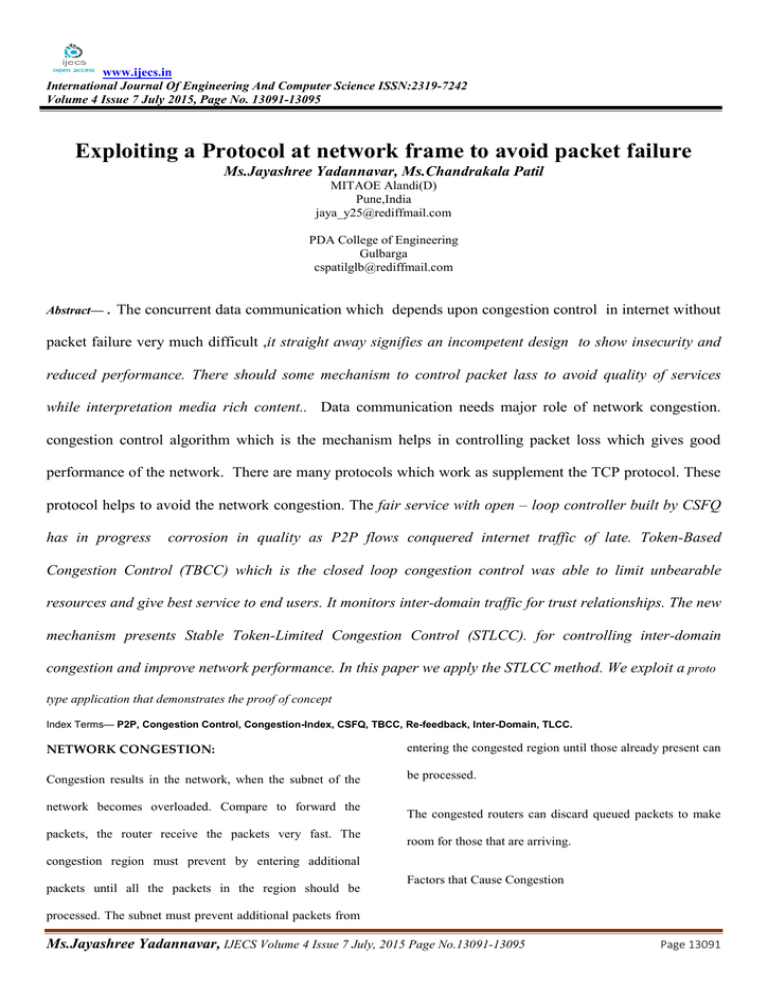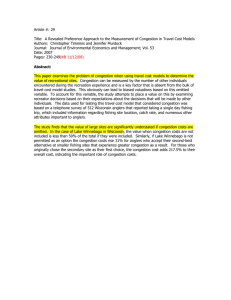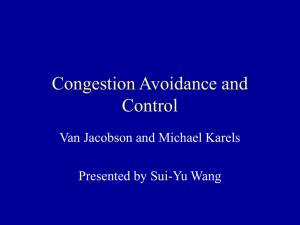www.ijecs.in International Journal Of Engineering And Computer Science ISSN:2319-7242
advertisement

www.ijecs.in International Journal Of Engineering And Computer Science ISSN:2319-7242 Volume 4 Issue 7 July 2015, Page No. 13091-13095 Exploiting a Protocol at network frame to avoid packet failure Ms.Jayashree Yadannavar, Ms.Chandrakala Patil MITAOE Alandi(D) Pune,India jaya_y25@rediffmail.com PDA College of Engineering Gulbarga cspatilglb@rediffmail.com Abstract— . The concurrent data communication which depends upon congestion control in internet without packet failure very much difficult ,it straight away signifies an incompetent design to show insecurity and reduced performance. There should some mechanism to control packet lass to avoid quality of services while interpretation media rich content.. Data communication needs major role of network congestion. congestion control algorithm which is the mechanism helps in controlling packet loss which gives good performance of the network. There are many protocols which work as supplement the TCP protocol. These protocol helps to avoid the network congestion. The fair service with open – loop controller built by CSFQ has in progress corrosion in quality as P2P flows conquered internet traffic of late. Token-Based Congestion Control (TBCC) which is the closed loop congestion control was able to limit unbearable resources and give best service to end users. It monitors inter-domain traffic for trust relationships. The new mechanism presents Stable Token-Limited Congestion Control (STLCC). for controlling inter-domain congestion and improve network performance. In this paper we apply the STLCC method. We exploit a proto type application that demonstrates the proof of concept Index Terms— P2P, Congestion Control, Congestion-Index, CSFQ, TBCC, Re-feedback, Inter-Domain, TLCC. NETWORK CONGESTION: entering the congested region until those already present can Congestion results in the network, when the subnet of the be processed. network becomes overloaded. Compare to forward the packets, the router receive the packets very fast. The The congested routers can discard queued packets to make room for those that are arriving. congestion region must prevent by entering additional packets until all the packets in the region should be Factors that Cause Congestion processed. The subnet must prevent additional packets from Ms.Jayashree Yadannavar, IJECS Volume 4 Issue 7 July, 2015 Page No.13091-13095 Page 13091 • • The outgoing link capacity exceeds by Packet arrival rate reduces transmission rate in presence of congestion • insufficient memory to store incoming packets • Bursty traffic • Slow processor • routers play little role This approach requires little support from routers, and Congestion occurs when the number of packets being therefore can be capably implemented speeds at high. To avoid this approach to work it is critical that, all end-host transmitted through the network approaches the cooperate - otherwise, well-mannered flows are not packet handling capacity of the network .Congestion protected against ill- mannered flows, can get hold of all control aims to keep number of packets below level at resources. which performance falls off dramatically End-hosts apply homogeneous control algorithms - otherwise, users implementing more aggressive control algorithms can get unfair advantage. To address this problem, we propose a network architecture and an algorithm, called Core-Stateless Fair Queueing (CSFQ), that significantly reduces the implementation complexity yet still achieves approximately fair allocations. The structural design differentiates between edge and core nodes. Edge nodes follow per flow management but core node Introduction does not follow the per flow management so implementation In today's Internet congestion control is achieved by relying can made efficient at high speeds. Edge node s are very TCP which is an end -to-end protocols. simpler as compare to regular queueing. Core-Stateless Fair Queuing (CSFQ) set up an open- loop control system at the network layer, which inserts the label of the flow arrival rate onto the packet header at edge routers and drops the packet at core routers based on the rate label if congestion happens .At core router to achieve approximate fair bandwidth allocation among flows with O (1) complexity started by CSFQ. It has turn into powerless when, the P2P flows started to www.cs.tau.ac.il/~mansour/networking-2006/Icc10.ppt govern the traffic of the Internet. Token-Based Congestion Control (TBCC) is based on a closed-loop congestion • dynamically estimates network state • packet loss signals congestion control principle, which restricts token resources consumed Ms.Jayashree Yadannavar, IJECS Volume 4 Issue 7 July, 2015 Page No.13091-13095 Page 13092 by an end-user and provides the fair best effort service with O(1) complexity. network resources, it retains the congestion control system stable. TOKEN : In this paper the token is a digital number in the Option Field of the datagram of the packet, which is written Fig. 1. Diffserv and SCORE network architectures. To overcome this problem the TBCC has to append inter- by the core and Edge routers when measure of the domain congestion control by introduces new protocol quality of services guaranteed by the router. This called stable-Token-Limited Congestion Control. So that the token number is read by the path routers and this TBCC that it makes congestion control system to be stable value measures the congestion. Based on this the edge router in the source will reduce the congestion. STABLE TOKEN LIMIT CONGESTION CONTROL (STLCC): With O(1) complexity,STLCC is able to outline output and input traffic at the inter-domain link The congestion index which is produced by STLCC and pushed the packet lost to the network edge. From this the performance of network will be improves. The collision problem is solved by this STLCC. www.cs.tau.ac.il/~mansour/networking-2006/Icc10.ppt CORE ROUTER: STLCC is working by adding the both algorithm of TLCC A core router is a computer communication system device and XCP together. The algorithm of XCP controls the and a network’s backbone. It provides multiple fast data output rate of sender. Therefore there is no chance of packet communication interfaces. The word "core" refers to a lost at the congestion link. Meanwhile, the entry token network’s overall physical structure. That forwards packets recourses are distributed to to computer hosts within a network(but not between incoming flows equally by edge routers. networks) some it contrasted with an edge router which When congestion happens, the incoming token as well as routes packets between a self-contained network and other congestion levels both increases in core router and outside networks along a network backbone. congested link respectively. STLCC helps in overcrowding stage sensibly, according to the access link it distributes EDGE ROUTER: Ms.Jayashree Yadannavar, IJECS Volume 4 Issue 7 July, 2015 Page No.13091-13095 Page 13093 The special router called edge router which is residing at the edge or border of a network. The web.cs.wpi.edu/~rek/Adv_Nets/Fall2014/CSF Q_F14.pd Conclusion: Deployed on the present Internet. STLCC can weigh up connectivity of the network and even with the external Congestion stage logically and assign network network is ensured by this edge network. This router uses resources according to the access link that leads to firm the outside the border gateway protocol can be used very Congestion control system. The network with constant extensively over the internet to supply the connectivity with Congestion control leads to the high-quality performance outside networks. Instead of only if message with an and it will be achievable to construct a network with internal network, which the core router already manages, an restricted number of resources having fast transmission of edge router may provide communication with different data with correctness and no delay. networks and autonomous systems. Edge routers use External BGP Protocol for data transmission because they are intermediary devices between two different networks Referance and operate at the external or border layer of the network. [1] Andrew S. Tanenbaum, Computer Networks, Prentice- There are a number of edge routers, together with edge Hall International, Inc. routers positioned at the outer boundary of the network as an [2] S. Floyd and V. Jacobson. Random Early Detection essential device for connecting the host network with the Gateways Internet. Without knowledge of the host administrator, when a node sends data on a for Congestion Avoidance, ACM/IEEE Transactions on Networking, August 1993. [3] Ion Stoica, Scott Shenker, Hui Zhang, "Core-Stateless Fair Queueing: A Scalable Architecture to Approximate Fair network the data packet is sent to the last router Bandwidth Allocations in High Speed Networks", In Proc. on the authorized network which is edge router. Of SIGCOMM, 1998. [4] D. Qiu and R. Srikant. Modeling and performance analysis of BitTorrent-like peer-to-peer networks. In Proc. of SIGCOMM, 2004. [5] Zhiqiang Shi, Token-based congestion control: Achieving fair resource allocations in P2P networks, Innovations in NGN: Future Network and Services, 2008. K-INGN 2008. First ITUT Kaleidoscope Academic Conference. Ms.Jayashree Yadannavar, IJECS Volume 4 Issue 7 July, 2015 Page No.13091-13095 Page 13094 [6] S. Blake, D. Black, M. Carlson, E. Davies, Z. Wang, and W. Weiss, “An architecture for differentiated services,” Dec.1998, Internet RFC 2475. [7] S. Katti, H. Rahul, W. Hu, D. Katabi, M. Medard, and J. Crowcroft,“XORs in the air: Practical wireless network coding,” Comput. Commun. Rev., vol. 36, pp. 243–254, 2006. [8] M. Effros, T. Ho, and S. Kim, “A tiling approach to network code design for wireless networks,” in Proc. Inf. Theory Workshop, 2006, pp.62–66 [9] Sally Floyd and Kevin Fall, Promoting the Use of Endto-End Congestion Control in the Internet, IEEE/ACM Transactions on Networking, August 1999 [10] Zhiqiang Shi, Yuansong Qiao, Zhimei Wu, Congestion Control with the Fixed Cost at the Domain Border, Future Computer and Communication (ICFCC), 2010. [11] Bob Briscoe, Re-feedback: Freedom with Accountability for Causing Congestion in a Connectionless Internetwork,http://www.cs.ucl.ac.uk/staff/B.Briscoe/project s/e2ephd/e2ephd_y9_cut down_appxs.pdf [12] Dina Katabi, Mark Handley, and Charles Rohrs, "Internet Congestion Control for Future High BandwidthDelay Product Environments." ACM Sigcomm 2002, August 2002 Ms.Jayashree Yadannavar, IJECS Volume 4 Issue 7 July, 2015 Page No.13091-13095 Page 13095



